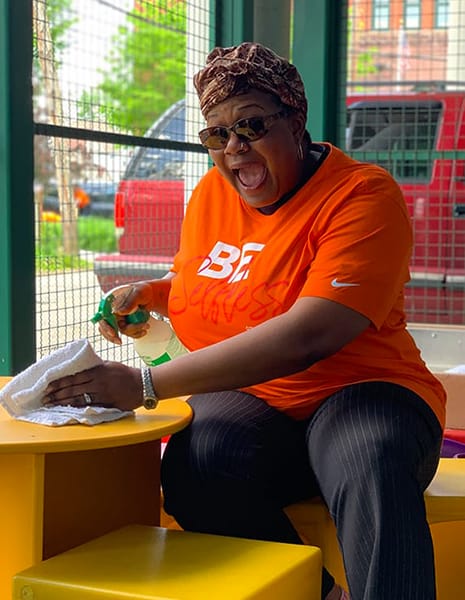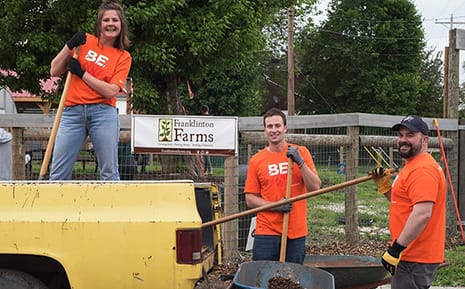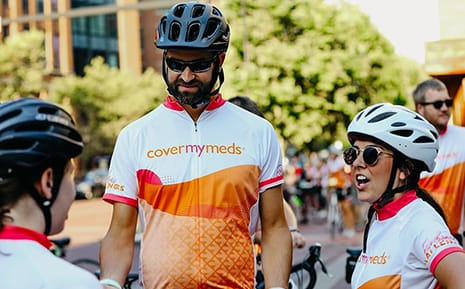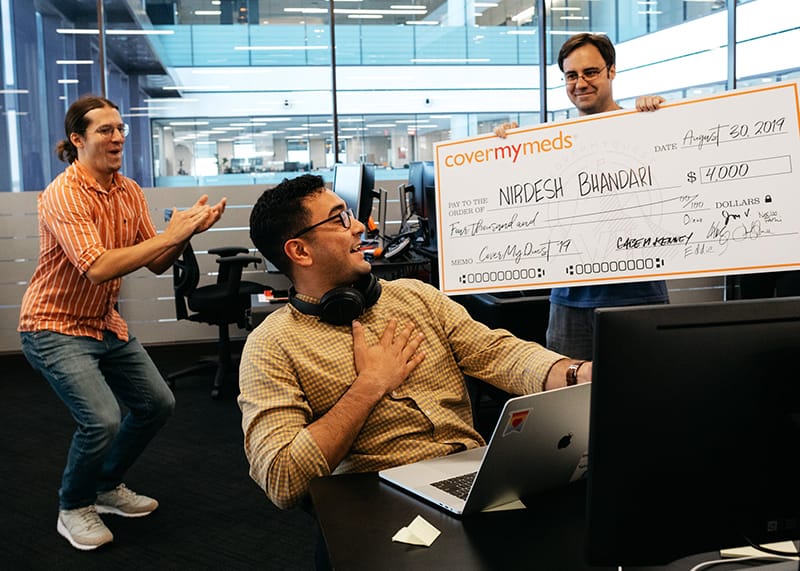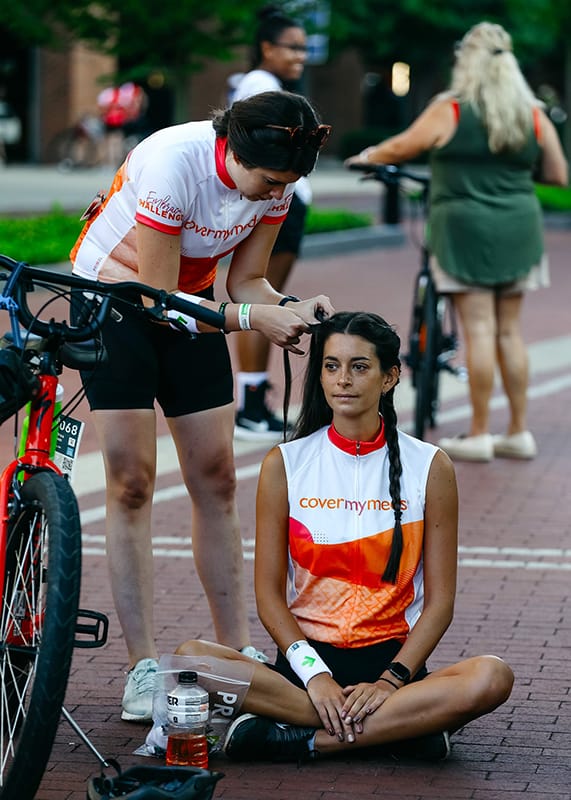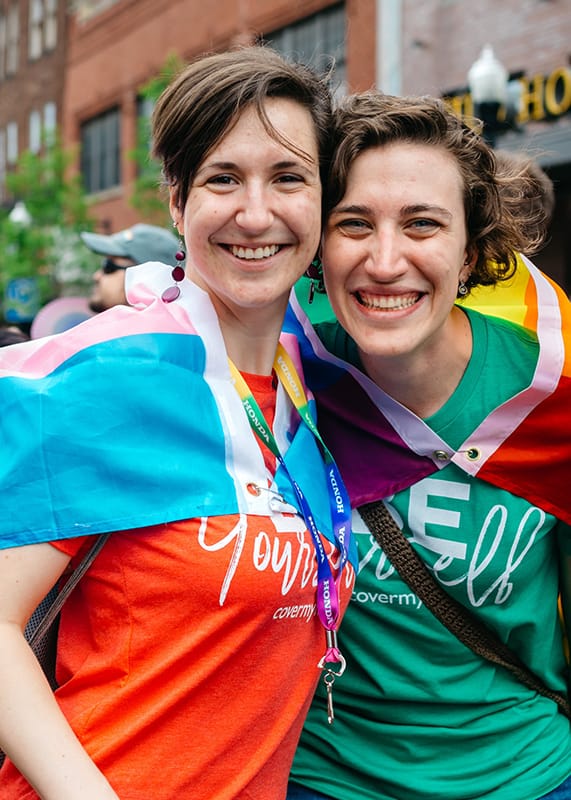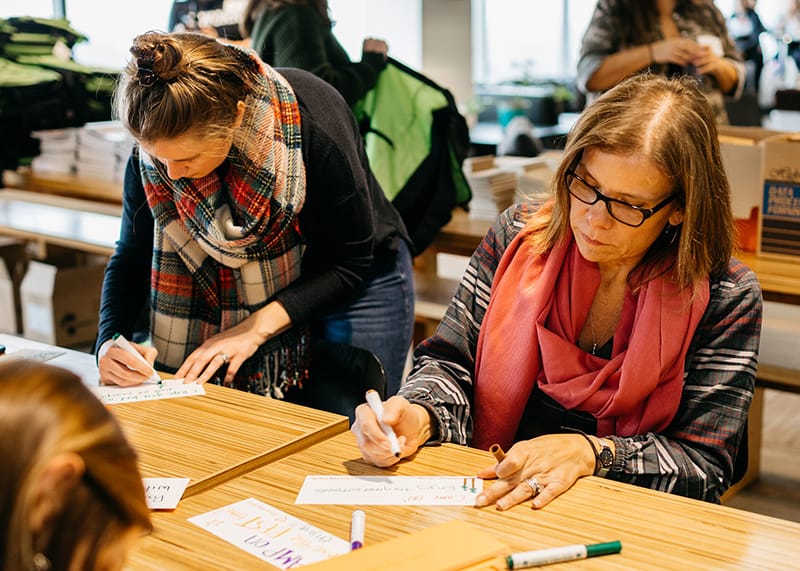
Leading the Charge for Alternative Transportation
Affecting big change isn’t easy — but it’s worth it. That’s the motivation driving CoverMyMeds employees who are committed to decreasing the number of cars on our roads.
Earlier this summer, the Alternative Commuting and Environmental Sustainability (ACES) team kicked off the inaugural Smart Mobility Week, five days dedicated to encouraging employees to rethink commuting routines. Events included “Ask Me Anything” sessions with experienced bus-riders, carpoolers and bicyclists, on-site electric-car test drives and a demo of the Modal-Trip Planning app. (The app encourages Central Ohioans to get around in new ways, from bus to scooter to Smart Circuit, Ohio’s first autonomous shuttle — learn more.
Throughout the week, employees shared selfies from the bus or bike, in their carpool groups and trying out electric cars provided by Smart Columbus, an organization committed to deploying more affordable, reliable and sustainable transportation options in the area.
“Reducing the single-occupancy-vehicle commuter rate at CoverMyMeds helps alleviate a strained parking situation, it reduces traffic congestion amid Columbus’ rapid population growth and, most importantly, it’s the right thing to do for our planet,” said ACES member Dave Humeston. “Accelerated climate change is real, and transportation activities are the largest contributor to carbon emissions. Commuting in a non-SOV method is a small behavior change that can make a significant impact. It’s a classic ‘think global, act local’ example.”
Living life car-free
Earlier this year, Alyssa Leonard gave up her car for good. We asked her about the logistics of getting to work without her own four wheels — and if it’s been the major sacrifice many may assume it is.
CMM: What’s your commuting journey been like? Why’d you decide to give alt commuting a try?
AL: When I was in college, I occasionally rode my bike to where I needed to go. But, not having a place to clean up when I got there was a major limiter — plus, cars were seemingly so much more convenient. I started at CMM in January and, as soon as I saw how we can bring bikes inside for safe storage and how we have access to showers, I started plotting. I had my old Wal-Mart bike, some cheap exercise gear and Google Maps’ bike-path overlay. As soon as the weather hit 40 degrees in March, I gave it a shot.
CMM: How long did it take for you to go “all in?”
AL: That first time, it took me two hours to get to work — via a 16-mile commute on the scenic route — with all the breaks I had to take. The first day, I biked in and caught a ride home. The next week, I carried my bike in on my car, biked home and then biked in the next morning so I had a night’s sleep to let my body recover. After a week or two, when I thought I could handle it, I did one day’s full commute via bike, then two days.
In May, I got rid of my car. These days, I bike three days a week and carpool with another CMM-er the other three (on Saturdays I work at a second job closer to home). By bike, my way home now takes only a little over an hour each way, and it’s an hour I get to appreciate nature, get in tune with my body and feel good about my commute rather than feel like it’s a waste of time. And, unlike with driving, you get better and faster at biking the more you do it, so my commute time is only going to continue shrinking.
On carpool days, I get to read, chat, enjoy the AC and let my muscles recover. I have plans to add more biking days as soon as I’m ready.
CMM: So, your car is gone … how difficult of a decision was that? What ultimately led you to that decision?
AL: It was a fruitful intersection of opportunity and ambition. In May, I had the opportunity to sell my aging car to a family member in need (so the process was relatively pain-free) and, as I was preparing for that event, a thought started nudging me: “After I get rid of this car, what if I just … don’t buy a new one?”
It was almost unthinkable, considering how far I live from work, but oh-so-seductive. I calculated how much money I spent each month on the car — between gas, maintenance, insurance and the inevitable breakages — and I imagined having that money for literally anything else. I imagined never having to circle around looking for a parking spot, or slowly roasting in a hot car while I stared at all the brake lights ahead of me. And I imagined the alternative: the hours I’d need to spend on research on what car to buy, of the car salesmen I’d have to smile at, of the money I’d have to spend, of the environmental impacts of yet another car on the road.
And so, in the end, it wasn’t that difficult of a decision at all. I promised myself that this was an experiment and that at any point I could back out and get a car again — but I am very stubborn and don’t like car salesmen.
CMM: What’s been the biggest challenge?
AL: There aren’t that many so far, believe it or not. There’s been the occasional struggle when I’ve needed to carry a lot of things, which can be remedied by more carrying capacity on my bike; I’m working on that. Come winter, I expect to deal with cold, snow and ice, but I see those as challenges rather than roadblocks. Minneapolis, for example, has a ton of bicyclists, and it’s practically Arctic. I’ll just experiment and see what works for me.
CMM: What do you share with others who are considering a commute change?
AL: I don’t think people realize how easy it is to bike to work. Since March, I’ve put in more than 650 miles over 42 bike rides, and that’s just on my creaky Wal-Mart bike. For the majority of people, it’s at least feasible — the challenge is just getting past the initial hesitance to try it out.
What also seems to work well is offering to ride with someone. A lot of the initial friction about biking is the fear of biking on streets alone, and the uncertainty of navigating where you need to go. You don’t notice them when you’re in a car, but we have a surprising number of bike lanes and options around; having someone with you to point these out can be comforting. (I have a standing invitation for anyone who wants to try out biking with someone who knows the road rules and has confidence.)
CMM: OK, real talk: Has it been tough, or easier than you thought it’d be?
AL: Physically, it’s been challenging. At every stage of the process, I’ve felt exhausted by the time I get home – but also hopped up on feel-good exercise hormones and excited by the progress I’d made that day. Sometimes in the morning, I need to push myself to get on the bike — but knowing I can’t just drive in helps to get me going (and I always end up having a good time).
Going uphill, getting hit by a blast of wind, a car getting too close for comfort – those moments can be tough. But, overall, the process has been easy, gradual and great for my physical and mental wellbeing.
CMM: What’s your “why”?
AL: Ultimately, it’s because cars suck. It amazes me how much we, as a culture, sacrifice on the altar of the automobile — simply because it’s the default mode of transportation. As an able-bodied person, I was able to get rid of mine and keep rolling to where I need to go, and I can’t say I’m suffering for it.
CMM: Smart Mobility Week — what session did you enjoy most?
AL: I love the diversity of transportation types we had on display, and I especially enjoyed learning about COTA bus options, as I think ahead to winter. And it was great to learn about local advocacy programs like Bike Friendly Franklinton and Yay! Bikes.
Above all, I loved all the dorky alt-commuting selfies. We have such a great group of people at CMM and in ACES, and it’s wonderful to feel like you’re a part of a team.
What's next?
CoverMyMeds recently announced a spot-sharing program, through which two or more employees share a company-provided parking spot — encouraging employees to find new ways to get to work and around the city on their “off” days. Chief Operating Officer Scott Gaines volunteered to be one of the first to give up a solo spot.
We also launched a partnership with SHARE, a door-to-door shuttle service free to CoverMyMeds employees who live within a specified distance from the Columbus offices.
“We took a survey last fall and found that CoverMyMeds has about an 89 percent SOV commuter rate, Columbus was around 84 percent and the national average is about 74 percent,” Humeston said. “Our goal is to reduce CoverMyMeds rate by 10 percentage points — to 79 percent — by this fall, measured by another survey.”
Want to follow along? Check in with our alt-commuting adventure on Instagram. For more about our culture and commitment to the community, visit our Campus page.
